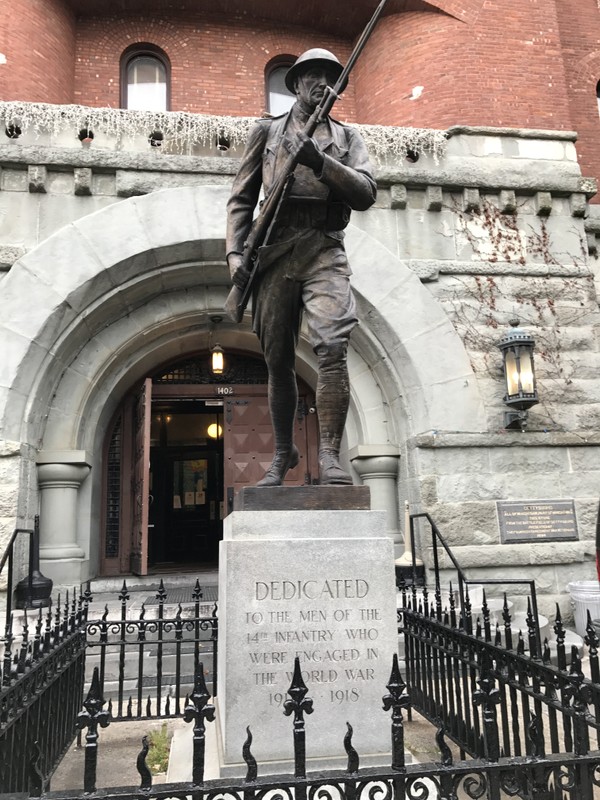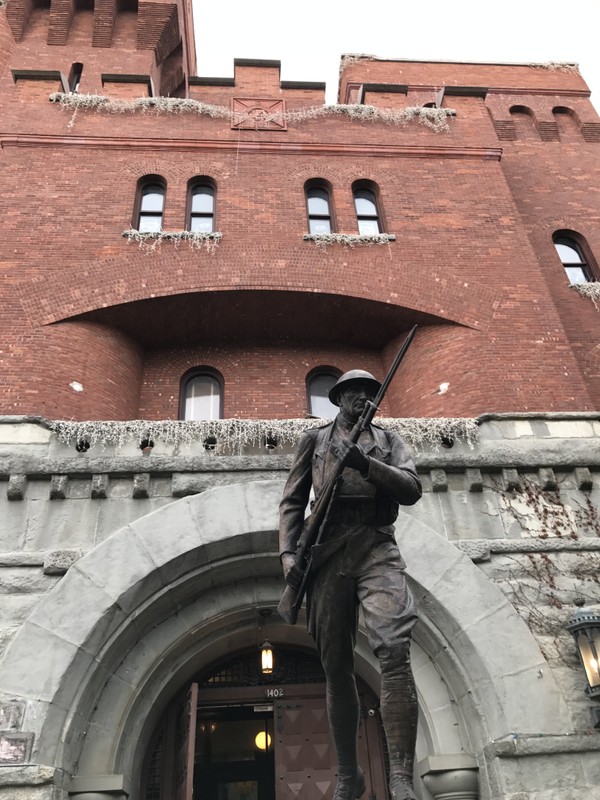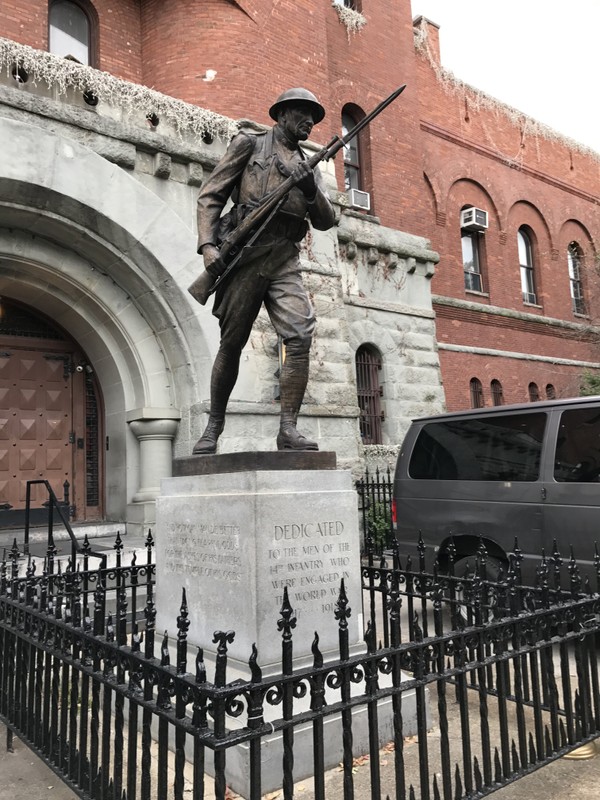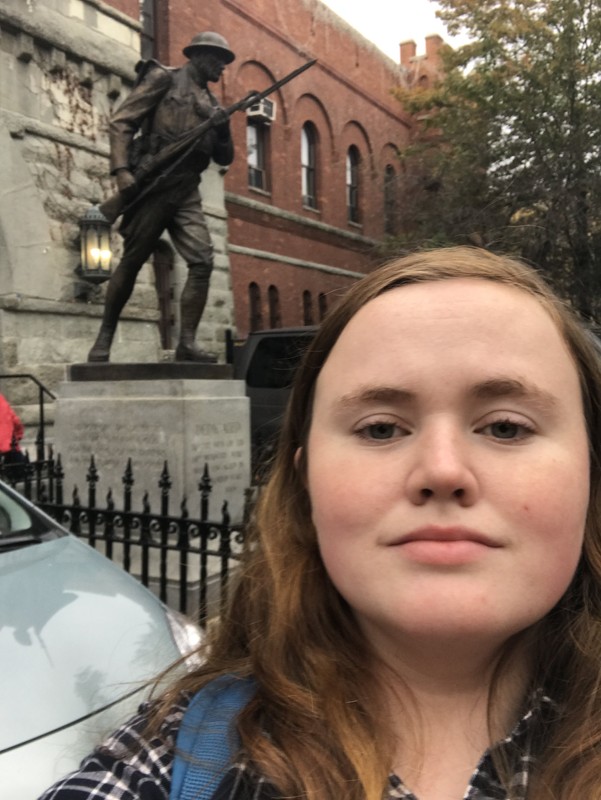Fourteenth Regiment Memorial
Introduction
Text-to-speech Audio
Images
Front of Statue, outside of Park Slope Armory, YMCA. Bronze depiction a World War I Infantry soldier or Doughboy- on 8th Avenue side of building, intersection between 8th Avenue and 15th StreetPhotographer:

Another front shot of statue, with exterior of building behind the statue. The building behind is the original armory building which has been converted into a community space, museum and YMCA

Left side of statue- on 8th Avenue side of building

For Human scale

Backstory and Context
Text-to-speech Audio
The statue, created by Anton Schaaf in 1923, stands on an inscribed granite base.1 The front of the pedestal reads "Dedicated to the Men of the 14th Infantry Who Were Engaged in the World War 1917-1918". The inscription on the rear of the base states, "To Commemorate and the Perpetuate their Heroic Services and their Unselfish Devotion to Duty". The sides of the granite base include two different quotes. One side has the quotation "Strike for Your Altars and Your Fires Strike for the Green Graves of Your Sires God and Your Native Land" and the other side reads "And How Can Man Die Better Than Facing Fearful Odds for the Ashes of His Fathers and the Temple of His Gods".2
The Fourteenth Regiment Memorial statue is a classic depiction of a doughboy, a World War I U.S. Soldier. 3 "A steel-helmeted infantryman, holding his rifle at the ready, bayonet in place, charges towards the enemy".4 The statue is paying respect to the 14th Infantry Regiment, a volunteer force which fought in World War I. 5
The statue was temporally removed on May 13, 1996 and returned on May 23 of the same year. It was removed in an attempt to preserve the armories historic sculptures. The statue was cleaned in order to clean off the collected grime and natural deterioration of the bronze in the elements. In response to neighborhood discontent, especially among veterans, the statue was returned to its original spot, as well as several other armory artifacts. 6
The Park Slope armory building, formerly known as the 14th Regiment Armory, is a short distance away from Prospect Park and multiple subway stations. The neighborhood surrounding the Armory was once home to mostly working class people, after the Great Depression. Today, however, many of the buildings are home to the middle and upper-middle class. 7
Within the Armory building there is a Veterans Museum, contributed to by veterans in the community and by the curators of the building itself. The Museum not only contains history of American veterans going back as far as the Revolutionary Way, but it also contains interesting facts and artifacts about New York City, the Park Slope Area and the Armory building itself. The website has extensive information on the museum.8 http://parkslopeveteransmuseum.net/
Cite This Entry
Natalie Gill and Andrew Lee. "Fourteenth Regiment Memorial ." Clio: Your Guide to History. September 27, 2019. Accessed April 4, 2025. https://theclio.com/tour/612/3
Sources
1 Wingate, Jennifer. "Over the Top: The Doughboy in World War I Memorials and Visual Culture." American Art 19, no. 2 (2005): 26-47. JSTOR.
2 Elmer Sprague. Brooklyn Public Monuments: Sculpture for Civic Memory and Urban Pride. Dog Ear Publishing, 2008, play.google.com/store/books/details?id=MawOyCCWR9gC.
3 Wingate, Jennifer. "Over the Top: The Doughboy in World War I Memorials and Visual Culture." American Art 19, no. 2 (2005): 26-47. JSTOR.
4 Elmer Sprague. Brooklyn Public Monuments: Sculpture for Civic Memory and Urban Pride. Dog Ear Publishing, 2008, play.google.com/store/books/details?id=MawOyCCWR9gC.
5 Michelle Young. “A Secret Veterans Museum Hidden in the Park Slope Armory, Brooklyn.”Untapped Cities,30 Mar. 2016, untappedcities.com/2016/03/30/a-secret-veterans-museum-hidden-in-the-park-slope-armory-brooklyn/.
6 Charisse Jones. "Veterans Get Their Doughboy Back." The New York Times. 24 May, 1996, http://www.nytimes.com/1996/05/24/nyregion/veterans-get-their-doughboy-back.html
7 Greg Young and Tom Meyers, "Park Slope and the Story of Brownstone Brooklyn," The Bowery Boys: New York City History, May 01, 2015, https://www.boweryboyshistory.com/2015/05/park-slope-and-the-story-of-browstone-brooklyn.html.
8 Lynette Williams, Melissa Czarnik, and Tom Miskel, "Park Slope Veterans Museum," Park Slope Veterans Museum, http://parkslopeveteransmuseum.net/
Natalie Gill (November 1, 2017)
Natalie Gill (November 1, 2017)
Natalie Gill (November 1, 2017)
Natalie Gill (November 1, 2017)

